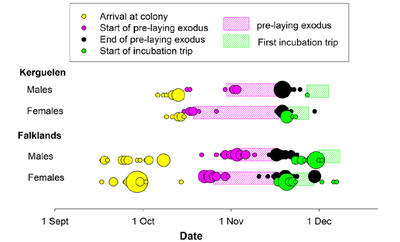Species distributions and behavioral flexibility
Sensors of the Sea - Ecology and Biogeography of pelagic Seabirds
Oceans cover two thirds of the earth, and birds of the order Procellariiformes (tube-nosed birds such as albatrosses, petrels, and storm petrels) are the seabirds best adapted to these high-seas habitats. Therefore, to study oceanic food chains, distribution, and population connectivity, a project on the feeding ecology and distribution of small tube-nosed species is appropriate. The project will help to better understand how different seabird populations use marine resources, and how flexible species are in adaptive as well as evolutionary contexts, especially during climate change.
Initial investigations of the project have already shown that the ranges of the two large populations of Thin-billed Prions (Pachyptila belcheri), which breed in distant oceanic areas, overlap outside the breeding season in the eastern Atlantic sector of the Southern Ocean1. Genetic analyses2 of three closely related species (P. belcheri, P. desolata, Halobaena caerulea) revealed little genetic differentiation between the two P. belcheri populations, despite distant breeding ranges. Contrary to expectations, this was also true for P. desolata, although their ranges did not overlap even outside the breeding season. The reason for this is probably the migration of the young birds, which roam around for several years before they select a population site for nesting2.
Both populations also migrate at different times and in opposite directions to reach their breeding territories. To investigate temporal coordination and differences in behavior on the breeding grounds, adult individuals from the Falklands and Kerguelen populations were fitted with miniature data loggers. Return to the breeding area, pre-exodus and pre-laying exodus occurred at different times and durations, but for egg laying and breeding both populations synchronized. In addition, individuals from the Falklands population were found to forage predominantly in neritic areas, where they fed on a variety of different organisms. In contrast, P. belcheri from the Kerguelen Archipelago foraged in oceanic waters south of the polar front for pre-laying exodus, where they fed almost exclusively on crustaceans. This results in significant differences in diet. These results indicate a high plasticity in the foraging behavior of thin-billed prions. This makes them a suitable candidate for studying mechanisms for temporal coordination of reproductive behavior under different environmental conditions.3

Fig. 1: Chronology of early breeding season of studied thin-billed prions; size of circles correlates with number of individuals entering or exiting a phase

Fig. 2: Areas determined by geolocation to be used by thin-billed prions for feeding during the pre-laying exodus3
References
1. Quillfeldt P, Cherel Y, Delord K, Masello JF, Delord K, McGill RAR, Furness RW, Moodley Y, Weimerkirch H (2015): Half a world apart? Overlap in nonbreeding distributions of Atlantic and Indian ocean thin-billed prions. PLoS ONE 01/2015; 10(5):e0125007. DOI:10.1371/journal.pone.0125007. http://journals.plos.org/plosone/article?id=10.1371/journal.pone.0125007
2. Quillfeldt P, Moodley Y, Weimerskirch H, Cherel Y, Delord K, Phillips RA, Navarro J, Calderón L, Masello JF (2017): Does genetic structure reflect differences in non-breeding movements? A case study in small, highly mobile seabirds. BMC Evolutionary Biology (2017) 17:160. DOI:https://doi.org/10.1186/s12862-017-1008-x. https://bmcecolevol.biomedcentral.com/articles/10.1186/s12862-017-1008-x
3. Quillfeldt P, Weimerskirch H, Masello JF, Delord K, McGill RA, Furness RW, Cherel Y (2019): Behavioural plasticity in the early breeding season of pelagic seabirds - a case study of thin-billed prions from two oceans. Movement Ecology 7:1. DOI:https://doi.org/10.1186/s40462-019-0147-7. https://link.springer.com/article/10.1186/s40462-019-0147-7
